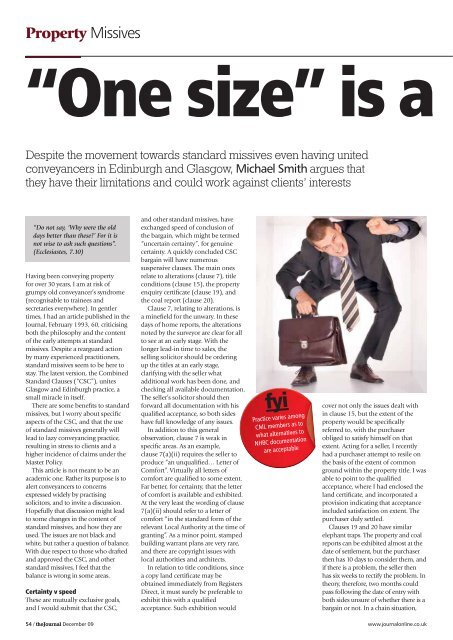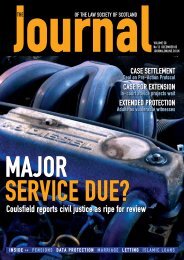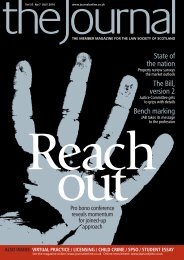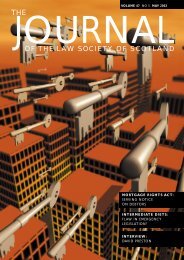Professional briefing - The Journal Online
Professional briefing - The Journal Online
Professional briefing - The Journal Online
You also want an ePaper? Increase the reach of your titles
YUMPU automatically turns print PDFs into web optimized ePapers that Google loves.
Property Missives<br />
“One size” is a<br />
Despite the movement towards standard missives even having united<br />
conveyancers in Edinburgh and Glasgow, Michael Smith argues that<br />
they have their limitations and could work against clients’ interests<br />
“Do not say, ‘Why were the old<br />
days better than these?’ For it is<br />
not wise to ask such questions”.<br />
(Ecclesiastes, 7.10)<br />
Having been conveying property<br />
for over 30 years, I am at risk of<br />
grumpy old conveyancer’s syndrome<br />
(recognisable to trainees and<br />
secretaries everywhere). In gentler<br />
times, I had an article published in the<br />
<strong>Journal</strong>, February 1993, 60, criticising<br />
both the philosophy and the content<br />
of the early attempts at standard<br />
missives. Despite a rearguard action<br />
by many experienced practitioners,<br />
standard missives seem to be here to<br />
stay. <strong>The</strong> latest version, the Combined<br />
Standard Clauses (“CSC”), unites<br />
Glasgow and Edinburgh practice, a<br />
small miracle in itself.<br />
<strong>The</strong>re are some benefits to standard<br />
missives, but I worry about specific<br />
aspects of the CSC, and that the use<br />
of standard missives generally will<br />
lead to lazy conveyancing practice,<br />
resulting in stress to clients and a<br />
higher incidence of claims under the<br />
Master Policy.<br />
This article is not meant to be an<br />
academic one. Rather its purpose is to<br />
alert conveyancers to concerns<br />
expressed widely by practising<br />
solicitors, and to invite a discussion.<br />
Hopefully that discussion might lead<br />
to some changes in the content of<br />
standard missives, and how they are<br />
used. <strong>The</strong> issues are not black and<br />
white, but rather a question of balance.<br />
With due respect to those who drafted<br />
and approved the CSC, and other<br />
standard missives, I feel that the<br />
balance is wrong in some areas.<br />
Certainty v speed<br />
<strong>The</strong>se are mutually exclusive goals,<br />
and I would submit that the CSC,<br />
54 / the<strong>Journal</strong> December 09<br />
and other standard missives, have<br />
exchanged speed of conclusion of<br />
the bargain, which might be termed<br />
“uncertain certainty”, for genuine<br />
certainty. A quickly concluded CSC<br />
bargain will have numerous<br />
suspensive clauses. <strong>The</strong> main ones<br />
relate to alterations (clause 7), title<br />
conditions (clause 15), the property<br />
enquiry certificate (clause 19), and<br />
the coal report (clause 20).<br />
Clause 7, relating to alterations, is<br />
a minefield for the unwary. In these<br />
days of home reports, the alterations<br />
noted by the surveyor are clear for all<br />
to see at an early stage. With the<br />
longer lead-in time to sales, the<br />
selling solicitor should be ordering<br />
up the titles at an early stage,<br />
clarifying with the seller what<br />
additional work has been done, and<br />
checking all available documentation.<br />
<strong>The</strong> seller’s solicitor should then<br />
forward all documentation with his<br />
qualified acceptance, so both sides<br />
have full knowledge of any issues.<br />
In addition to this general<br />
observation, clause 7 is weak in<br />
specific areas. As an example,<br />
clause 7(a)(ii) requires the seller to<br />
produce “an unqualified… Letter of<br />
Comfort”. Virtually all letters of<br />
comfort are qualified to some extent.<br />
Far better, for certainty, that the letter<br />
of comfort is available and exhibited.<br />
At the very least the wording of clause<br />
7(a)(ii) should refer to a letter of<br />
comfort “in the standard form of the<br />
relevant Local Authority at the time of<br />
granting”. As a minor point, stamped<br />
building warrant plans are very rare,<br />
and there are copyright issues with<br />
local authorities and architects.<br />
In relation to title conditions, since<br />
a copy land certificate may be<br />
obtained immediately from Registers<br />
Direct, it must surely be preferable to<br />
exhibit this with a qualified<br />
acceptance. Such exhibition would<br />
fyi<br />
Practice varies among<br />
CML members as to<br />
what alternatives to<br />
NHBC documentation<br />
are acceptable<br />
cover not only the issues dealt with<br />
in clause 15, but the extent of the<br />
property would be specifically<br />
referred to, with the purchaser<br />
obliged to satisfy himself on that<br />
extent. Acting for a seller, I recently<br />
had a purchaser attempt to resile on<br />
the basis of the extent of common<br />
ground within the property title. I was<br />
able to point to the qualified<br />
acceptance, where I had enclosed the<br />
land certificate, and incorporated a<br />
provision indicating that acceptance<br />
included satisfaction on extent. <strong>The</strong><br />
purchaser duly settled.<br />
Clauses 19 and 20 have similar<br />
elephant traps. <strong>The</strong> property and coal<br />
reports can be exhibited almost at the<br />
date of settlement, but the purchaser<br />
then has 10 days to consider them, and<br />
if there is a problem, the seller then<br />
has six weeks to rectify the problem. In<br />
theory, therefore, two months could<br />
pass following the date of entry with<br />
both sides unsure of whether there is a<br />
bargain or not. In a chain situation,<br />
www.journalonline.co.uk










